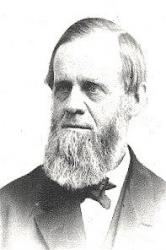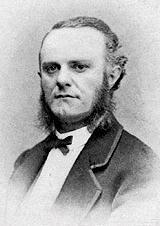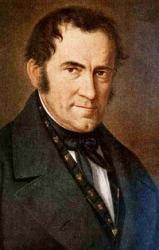Planning worship?
Check out our sister site, ZeteoSearch.org,
for 20+ additional resources related to your search.
- |
User Links
Person Results
‹ Return to hymnal





Export as CSV
Friedrich Filitz
1804 - 1876 Person Name: Friedrich Filitz, 1804-1876 Hymnal Number: 547 Composer of "MANNHEIM" in African Methodist Episcopal Church Hymnal Friedrich Filitz PhD Germany 1804-1876. Born at Arnstadt. Thuringia, he was a German composer and musicologist. He collected church music. He also studied philosophy. In 1833 he worked in Berlin as a music critic and at other employment. He was also a music historian. With Ludwig Erck, he published a collection of 15th & 17th Century chorales in 1845. He moved to Munich and published a chorale book in 1847. His legacy of vauable church music was donated to the Bavarian State Library, where it has made many forgotten works available once again. He died in Bonn, Germany.
John Perry
Friedrich Filitz
Samuel Wolcott

1813 - 1886 Person Name: Samuel Wolcott, 1813-1886 Hymnal Number: 565 Author of "Christ for the World We Sing" in African Methodist Episcopal Church Hymnal Wolcott, Samuel, D.D., was born at South Windsor, Connecticut, July 2, 1813, and educated at Yale College, 1833, and Andover Theological Seminary, 1837. From 1840 to 1842 he was a missionary in Syria. On his return to America he was successively pastor of several Congregational congregations, including Belchestown, Massachusetts; Providence, Rhode Island; Chicago, &c. He was also for some time Secretary of the Ohio Home Missionary Society. He died at Longmeadow, Massachusetts, Feb. 24, 1886. His hymnwriting began late in life, but has extended to more than 200 hymns, many of which are still in manuscript. Those of his hymns which have come into common use include:—
1. All thy realms in midnight shrouded. Mission. In the Oberlin Manual of Praise, 1880.
2. Christ for the world we sing. Missions. Written Feb. 7, 1869. Its origin is thus recorded by the author: "The Young Men's Christian Associations of Ohio met in one of our Churches, with their motto, in evergreen letters over the pulpit, ‘Christ for the World, and the World for Christ.' This suggested the hymn 'Christ for the world we sing.'" It was when on his way home from that service that he composed the hymn. It is in several American collections, including Laudes Domini, 1884, &c.
3. Father, I own Thy voice. Trust and Aspiration. This, his first hymn, was written in 1868, more as an experiment in hymn-writing than anything else. It was published in the Rev. Darius E. Jones's Songs for the New Life. Chicago, 1869. It has since passed into other collections.
4. Goodly were thy tents, 0 Israel. Missions. Written May 31, 1881, and included in Laudes Domini, 1884.
5. Lo! the faith which crossed the ocean. Missions. In the Oberlin Manual of Praise, 1880.
6. O gracious Redeemer! O Jesus our Lord. The Love of Jesus. Written in 1881.
7. On the works of His creation, God the Creator.
In the Ohio Evangelical Association's Hymn Book, 1881.
8. Pitying Saviour, look with blessing. Prayer for the Penitent. In the Ohio Evangelical Association's Hymn Book, 1881.
9. Tell me Whom my soul doth love. Opening of Divine Service. A paraphrase of Cant. i. 8. Written Feb. 6, 1870. Included in Laudes Domini, N. Y., 1884.
10. To us have distant ages. Saints Days. In Dale's English Hymn Book, 1874.
11. This house, most holy Lord, is Thine. Opening of a Place of Worship. In Dale's English Hymn Book, 1874.
For most of the information given above we are indebted to Duffield's English Hymns, N. Y., 1886.
-- John Julian, Dictionary of Hymnology (1907)
================
See also in:
Hymn Writers of the Church
Samuel Wolcott
John S. Dwight

1813 - 1893 Hymnal Number: 121 Translator of "O Holy Night" in African Methodist Episcopal Church Hymnal John Sullivan Dwight, born, in Boston, May 13, 1813, was a virtuoso in music, and an enthusiastic student of the art and science of tonal harmony. He joined a Harvard musical club known as "The Pierian Sodality" while a student at the University, and after his graduation became a prolific writer on musical subjects. Six years of his life were passed in the "Brook Farm Community." He was best known by his serial magazine, Dwight's Journal of Music, which was continued from 1852 to 1881. His death occurred in 1893.
The Story of the Hymns and Tunes, Brown & Butterworth, 1906.
=====================
Dwight, John Sullivan, son of Timothy Dwight (p. 316, ii.), was born at Boston, U.S.A., May 13, 1812, and educated at Harvard, and at the Cambridge Theological College. He laboured in the ministry for six years, and then devoted himself to literary work. For nearly 30 years he was editor of a Journal of Music. His connection with hymnody is very slight. (See "God bless our native land," p. 1566, i.)
--John Julian, Dictionary of Hymnology, Appendix, Part II (1907)
John S. Dwight
George Kingsley
1811 - 1884 Person Name: George Kingsley, 1811-1884 Hymnal Number: 14 Composer of "ELIZABETHTOWN" in African Methodist Episcopal Church Hymnal Born: July 7, 1811, Northampton, Massachusetts.
Died: March 14, 1884, Northampton, Massachusetts.
Kingsley played the organ at the Old South Church and Hollis Street Church in Boston, Massachusetts. He also taught music at Girard College in Philadelphia, Pennsylvania, served as music supervisor for public schools in Philadelphia, and compiled a number of music books, including:
Sunday School Singing Book, 1832
The Harmonist, 1833
The Social Choir, 1836
The Sacred Choir, 1838
The Harp of David, 1844
The Young Ladies’ Harp, 1847
Templi Carmina (Northampton, Massachusetts: 1853)
The Juvenile Choir, 1865
--www.hymntime.com/tch
George Kingsley
Louis M. Gottschalk

1829 - 1869 Person Name: Louis M. Gottschalk, 1829-1869 Hymnal Number: 198 Composer of "MERCY" in African Methodist Episcopal Church Hymnal Louis Moreau Gottschalk USA 1829-1869. Born in New Orleans, LA, to a Jewish father and Creole mother, he had six siblings and half-siblings. They lived in a small cottage in New Orleans. He later moved in with relatives (his grandmother and a nurse). He played the piano from an early age and was soon recognized as a prodigy by new Orleans bourgeois establishments. He made a performance debut at the new St. Charles Hotel in 1840. At 13 he left the U.S. And went to Europe with his father, as they realized he needed classical training to fulfill his musical ambitions. The Paris Conservatory rejected him without hearing him play on the grounds of his nationality. Chopin heard him play a concert there and remarked, “Give me your hand, my child, I predict that you will become the king of pianists. Franz Liszt and Charles Valentin Alkan also recognized his extreme talent. He became a composer and piano virtuoso, traveling far and wide performing, first back to the U.S., then Cuba, Puerto Rico, Central and South America. He was taken with music he heard in those places and composed his own. He returned to the States, resting in NJ, then went to New York City. There he mentored a young Venezuelan student, Carreno, and became concerned that she succeed. He was only able to give her a few lessons, yet she would remember him fondly and play his music the rest of her days. A year after meeting Gottschalk, she performed for President Lincoln and went on to become a renowned concern pianist, earning the nickname “Valkyrie of the Piano”. Gottschalk was also interested in art and made connections with notable figures of the New York art world. He traded one of his compositions to his art friend, Frederic Church, for one of Church's landscape paintings. By 1860 Gootschalk had established himself as the best known pianist in the New World. He supported the Union cause during the Civil War and returned to New Orleans only occasionally for concerts. He traveled some 95,000 miles and gave 1000 concerts by 1865. He was forced to leave the U.S. later that year as a result of a scandelous affair with a student at Oakland Female Seminary in Oakland, CA. He never came back to the U.S. He went to South America giving frequent concerts. At one, in Rio de Janeiro, Brazil, he collapsed from yellow fever as he played a concert. He died three weeks later, never recovering from the collapse, possibly from an overdose of quinine or an abdominal infection. He was buried in Brooklyn, NY. Though some of his works were destroyed or disappeared after his death, a number of them remain and have been recorded by various artists.
John Perry
Louis M. Gottschalk
John Morison
1750 - 1798 Person Name: John Morison, 1750-1798 Hymnal Number: 101 Author of "The Race That Long in Darkness Pined" in African Methodist Episcopal Church Hymnal Morison, John, D.D., was born in Aberdeenshire in 1749. He studied at the University of Aberdeen (King's College), where he graduated M.A. in 1771. In 1780 he became parish minister of Canisbay, Caithness. He received the degree of D.D. from the University of Edinburgh in 1792. He died at Canisbay, June 12, 1798. He was one of the members added on May 26, 1781, to the Committee appointed by the General Assembly of 1775 to revise the Translations and Paraphrases of 1745. To him are ascribed Nos. 19, 21, 29, 30 and 35, in the 1781 collection, and he is said to have been joint author with John Logan of Nos. 27 and 28. [Rev. James Mearns, M.A.]
--John Julian, Dictionary of Hymnology (1907)
John Morison
Lewis H. Redner

1831 - 1908 Person Name: Lewis H. Redner, 1830-1908 Hymnal Number: 109 Composer of "ST. LOUIS" in African Methodist Episcopal Church Hymnal Lewis Henry Redner (1831-1908) was born in Philadelphia, where he became a real estate agent and served on weekends as an organist and Sunday School Superintendent. He spent nineteen years at Holy Trinity church where Phillip Brooks was rector, and is credited with increasing attendance at the Sunday School from thirty-one to more than a thousand. In 1868 Brooks asked him to write a tune for his new text for children inspired by his recent trip to Bethlehem. Redner composed the tune the night before it was to be sung in worship on Sunday morning. The text and tune were first published in 1894 in The Church Porch, where the tune was named ST. LOUIS, possibly after the composer’s name. Redner is remembered today because of this one tune that has remained a Christmas favorite.
Emily Brink
Lewis H. Redner
Franz Xaver Gruber

1787 - 1863 Person Name: Franz Gruber, 1787-1863 Hymnal Number: 116 Composer of "STILLE NACHT" in African Methodist Episcopal Church Hymnal Franz Xaver Gruber (1787-1863) was born into a linen weaver's family and studied violin and organ even though his father wanted him to work in the family business. In addition to serving as parish organist for St. Nicholas Church in Obendorf, he taught school in nearby Arnsdorf (1807-1829) and Berndorf (1829-1833). He spent the balance of his career as organist and choir director in Hallein, where he founded the famous Hallein Choral Society.
Bert Polman
Franz Xaver Gruber
Charles J. Butler
Person Name: C. J. Butler Hymnal Number: 359 Author of "Since Christ my Soul from Sin Set Free (Where Jesus Is, 'Tis Heaven There)" in African Methodist Episcopal Church Hymnal Charles J Butler USA 1860- Butler, a Methodist, speaks of a voyage he took from his home, Camden, NJ, as a bachelor, to Britain around 1894, stating he roamed around the British Isles for 14 months through Scotland, Ireland, Britain, and Paris, dealing with ship stewards, street urchins, and visiting famous sights. He wrote about his trip in 1901. He later resided in Philadephia and was a salesman and musician. He wrote “Heart Melodies #3” with Charles Bentley (1897). He is possibly the listed secretary of the YMCA in Philadelphia in 1920.
John Perry
Charles J. Butler
Chester G. Allen
1838 - 1878 Person Name: Chester G. Allen, 1838-1878 Hymnal Number: 92 Composer of "JOYFUL SONG" in African Methodist Episcopal Church Hymnal Chester G. Allen was known as a teacher, composer and musical writer. He taught music in Cleveland, Ohio public schools. He also edited and compiled collections of music for schools and churches, containing many of his own compositions.
Nancy Naber
Chester G. Allen


 My Starred Hymns
My Starred Hymns


